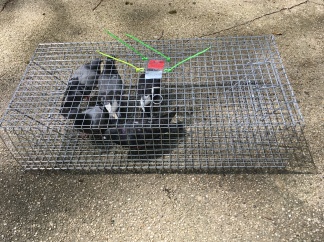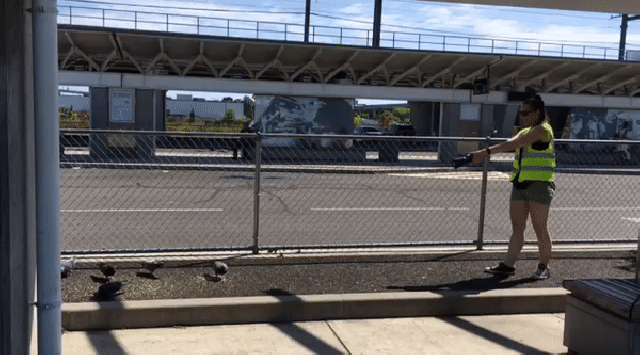Collecting samples in urban environments can present some challenges (as Matt Combs describes in “The Good, The Bad, and The Smelly” and Jane Remfert describes in “Urban Residential Field Tip”). As someone working on pigeons in Northeastern cities, I’ve encountered problems while simply trying to collect my samples. Many ornithologists use mist nets, but these are not practical for the places I needed to collect from — it would be inconvenient to block an entire sidewalk in NYC with a net, and I would still have to wait for the birds to come to me. For medium & large birds, researchers often use shotguns or airguns. Birds are collected, sampled, and then put into museums for future scientists. Again, however, it is not practical (nor safe) for me to be using a firearm on city streets.
When I first started collecting, I spoke with others who recommended a walk-in trap. I purchased a couple of traps and rigged up my car into a pigeon-mobile. I cut out a piece of old carpet and Elle Barnes (my partner in all fieldwork tests) and I drove to a spot with pigeons. We rolled out the carpet on the roof of my car, placed the pigeon trap on top of the car, threw birdseed all around the car, and into the trap, and waited. By at the end of the day we had caught nothing!

In the meantime, was also leaving a trap on the roof of my building. This required approval from the board of my building, keys to the roof from my super, and dragging my trap up a bunch of flights of stairs. After two weeks of baiting the trap daily I finally caught two pigeons. I moved the trap to my university and set it up outside the Biology building. Again, two weeks of baiting and still only a few birds. While I was slightly more successful in this location, I soon realized that this was not going to be a sustainable method to get the hundreds of samples I needed.
Finally I decided to invest in a net gun. While expensive, I thought this tool might be able to help me get all the samples I needed. It took awhile to get approval from my Institutional Animal Care and Use Committee and then I had to be tested by my advisor to make sure I could hit my target.

On a cold day in December my lab mate, Nicole Fusco, and I went out into the streets of Manhattan. Not too long after searching we came across a group of pigeons on the ground. I quickly pulled my car over, we jumped out and donned our yellow safety vests. Nicole distracted the pigeons by throwing birdseed on the ground and I pressurized my gun and aimed. BOOM! The gun went off and we caught four pigeons! And like that my sampling changed.
I now use my net gun to collect all over the Northeast. While I get some weird looks from people, it’s worth it for the hundreds of pigeon samples I’ve now collected.
Some notes about the net gun in case you’re thinking about using it.
- Because the net gun uses CO2 cartridges to pressurize the system, it needs to be pressurized and used within a few minutes.
- The net gun is loud and has a slight kickback. While not a real gun, I always try to warn people that are nearby before I use it.
- The whole system has to be reset and reassembled after every shot. Depending on how tangled the net gets it can take upwards of 10 minutes to reset the system.
- The nets are reusable but a hassle to get back into the net head.
- The CO2 cartridges are one time use and cost around $1.00 each. The cheapest place I’ve found to buy the cartridges is Adventures in Homebrewing. So far I haven’t gotten pushback from my university about buying from a homebrewing site.
- Sometimes I have to cut holes in the net to get the birds out. I’ve been using nylon string and superglue to repair the holes.
- The “switch plate” portion of my gun has broken multiple times. I now carry at least one backup switch plate with me at all times.

Are you considering using a net gun for your research? Wondering if it will work or want to chat about the problems I’ve encountered while using it? Comment below or email me through my website.
